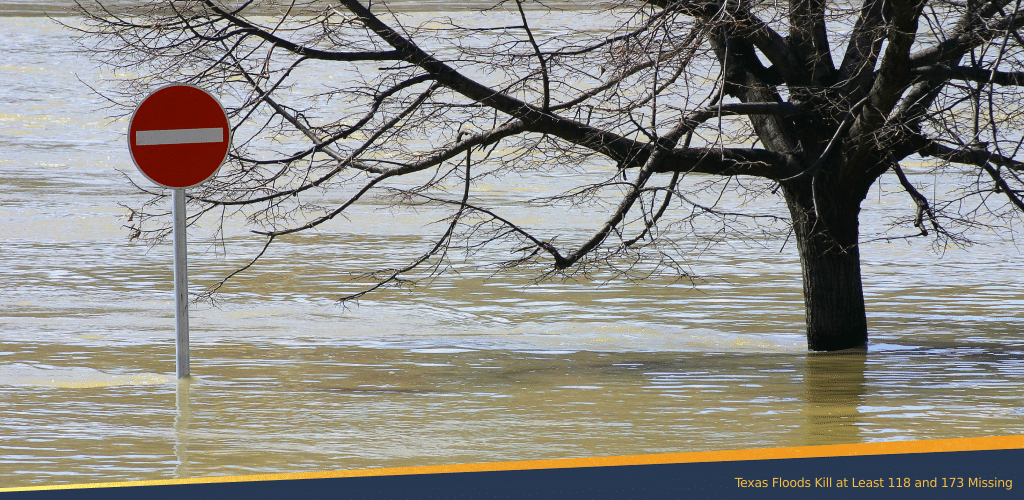
The recent Texas floods have left the state reeling from one of the deadliest natural disasters in recent history. With at least 131 lives confirmed lost and 101 people still missing, communities across the Texas Hill Country are mourning, searching, and demanding answers.
The devastating flash flooding overwhelmed creeks and rivers with little warning, catching families, campers, and entire towns off guard. As emergency response teams work around the clock, residents and officials alike are asking how this happened—and how it can be prevented from happening again.
Flash Flooding in Texas Turns Deadly
Flash flooding in Texas is not uncommon, but the July 2025 storm system unleashed a level of devastation few anticipated. Torrential rains swept through Kerr County and surrounding areas, dumping more than 20 inches of rain in some places. Creeks overflowed, roadways turned to rivers, and the Guadalupe River surged by over 26 feet in just 45 minutes.
The speed and force of the water turned otherwise familiar landscapes into life-threatening traps. In particular, campgrounds near the Guadalupe were hardest hit—many of them full of children attending summer programs. Parents, staff, and rescuers scrambled to evacuate, but in many places, the water came too quickly.
What Made This Flash Flood So Sudden and Dangerous?
Meteorologists attributed the intensity of the flooding to a stalled weather system that released concentrated rainfall over already saturated ground. The region’s steep terrain and narrow waterways channeled the water quickly, creating classic flash flood conditions: high water, no warning, and no time to escape.
The Gap Between Official Warnings and Real-World Readiness
According to reporting from the Texas Tribune, the National Weather Service issued a flash flood warning 3 hours and 21 minutes before the floodwaters peaked along the Guadalupe River. While timely on paper, the alert was insufficient in practice.
The speed and intensity of the storm, coupled with limited public notification infrastructure, meant many residents and campers never saw or heard the warning or were unable to act quickly enough.
Despite clear risks and past flood events, Kerr County has lacked a robust early warning system. For years, local officials proposed installing real-time river gauges, outdoor sirens, and mobile alert infrastructure, yet repeated requests for state and federal funding were denied or delayed.
When the July 2025 floodwaters surged through the Hill Country, those systems were still not in place. Communities were left with no effective forewarning, and lives were lost as a result.
This is exactly why the community-led fundraiser “Hearts of the Hills” was launched. Organized by John Black, co-founder of Daly & Black, P.C., the campaign seeks to raise $1 million to finally implement the critical infrastructure that was previously left unfunded. The goal is simple: ensure Kerr County families never again face a flood without time to act.
Children Among the Missing
One of the most heartbreaking elements of the disaster is the number of children unaccounted for. At least 173 people are still missing, many of them children attending overnight summer camps located near the Guadalupe River. Camp Mystic was particularly affected, with 27 campers and staff confirmed dead and others still unaccounted for.
First responders, including the Texas National Guard and volunteer rescue teams, have been conducting land, water, and aerial searches. Parents have gathered near emergency command posts, clinging to hope and bracing for news. The emotional toll is impossible to quantify.
Emergency Response and Community Rescue Efforts
Local law enforcement, emergency management, and FEMA officials quickly mobilized in the flood’s aftermath. Helicopters airlifted stranded individuals from rooftops. Swift water rescue teams pulled people from submerged vehicles. Temporary shelters were set up in schools, churches, and community centers.
Grassroots support has also been overwhelming, with local businesses having donated food and supplies, and volunteers who have assisted with search efforts and helped displaced families. In Kerr County, a $1 million fundraiser titled “Hearts of the Hills” has been launched to fund the very flood alert infrastructure that could have saved lives.
FAQ
How many people have died in the recent Texas floods?
As of the latest reports, at least 118 people have died due to flash flooding across the Texas Hill Country.
How many children are currently missing due to the floods?
At least 173 people remain missing, many of whom are children who were attending summer camps near the Guadalupe River.
Why did the flood become so sudden and dangerous?
The flash flood was fueled by intense rainfall over already saturated ground, combined with steep terrain and inadequate early warning systems.
Can I help?
Yes. One of the most impactful ways to support is by contributing to the Hearts of the Hills fundraiser. Your donation will help fund critical flood alert infrastructure in Kerr County, giving families more time to prepare and evacuate in future emergencies.
A Call for Preparedness and Action
The 2025 Texas floods have left a permanent mark on communities throughout the Hill Country. The loss is staggering, and the grief immeasurable. But in the midst of tragedy, there is also a call to act: to invest in safety, to demand accountability, and to never let something like this happen again without warning.
To support ongoing recovery and flood warning system efforts in Kerr County, consider donating to Hearts of the Hills.
Lives can’t be replaced. But they can be honored through action.
